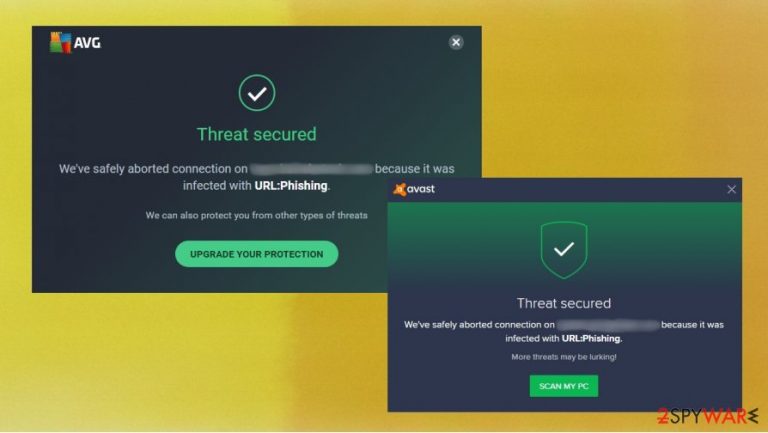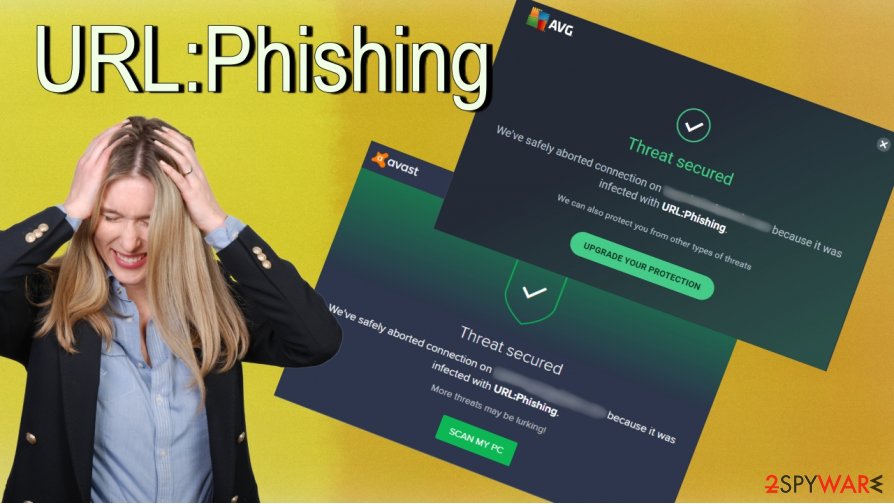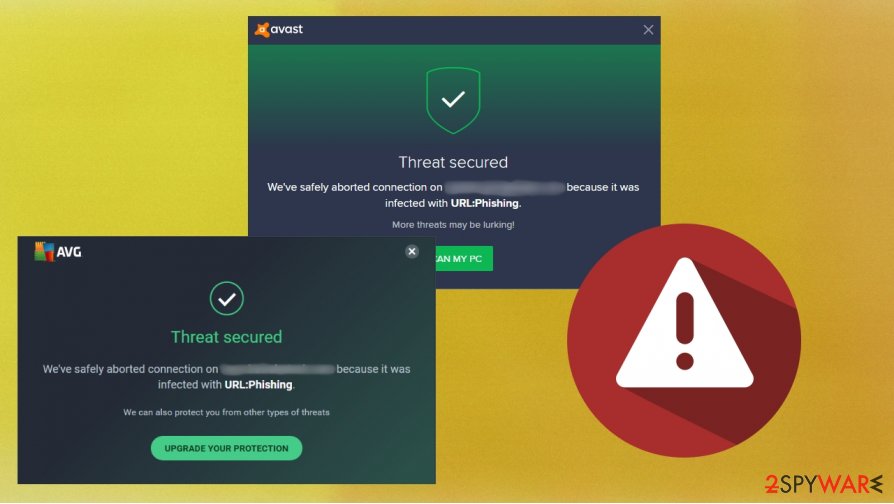URL:Phishing (Free Guide) - Removal Instructions
URL:Phishing Removal Guide
What is URL:Phishing?
URL:Phishing is a false threat warning message that can occur because you have adware on the computer

URL:Phishing – is a false antivirus detection engine warning that occurs to users even though the website they are trying to load is safe. This false detection can be the result of incompatible software or driver issues. In other cases, it can indicate the malicious executable or potentially unwanted program that runs in the background of your computer.
There are numerous complaints[1] about URL:Phishing false warnings. The same problem occurs on Avast and AVG.[2] Users not only get the notification about the threat but also can't visit the page they desired to load because the AV tool does not allow access to it. Sometimes people notice processes running on the Task Manager or in the background that indicates the potentially unwanted program or even malicious infection.
If you are one of these users and you don't know what to do, try to use our simple URL:Phishing removal guide. You can find it at the bottom of this article. But first, try to make sure that the warning is a false positive and not related to a serious infection by running another av engine for a double-checking.
| Name | URL:Phishing |
| Type | Heuristic detection that possibly indicates PUP/ malicious site |
| Purpose | To make users install fake software or expose their personal data |
| Main dangers | Malware infiltration, identity theft, stolen money from a bank account |
| Symptoms | Fake messages, redirects, pop-up ads, etc. |
| Distribution | Software bundling, unsafe websites |
| Elimination | Check our manual guide below or try to use different anti-malware tool |
| Fix damage | You can get rid of URL:Phishing possible damage by using the FortectIntego repair tool |
In fact, the AV tool monitors your internet activity and tries to block URLs that look dangerous. When an antivirus program works properly, URL:Phishing warning means that the AV tool detected possible phishing URL and prevented you from entering it. But if you see these warnings constantly or the tool tries to block safe sites, there is a high probability that your system is suffering from potentially unwanted programs (PUPs) or other problems.
You should remember that even though some people call it URL:Phishing virus, this detection is not a virus itself. Moreover, it is not reported to be associated with any serious malware. In most cases, users are suffering from false-positive notification because they have PUP on their computer or there are some compatibility problems.
Moreover, try to use different security tools to see if URL:Phishing detection shows up on other antivirus programs too. But do not run a few security tools at the same time because it can trigger compatibility issues and more false positives that might confuse you further. Firstly disable one and only then run another program.

Also, experts[3] say that even if you avoid insecure sites, you can still suffer from PUP infections. They are spreading through email attachments or fake ads that redirect to unsafe pages where the URL:Phishing detection gets triggered. Try to be very careful with advertisements and emails you get from strangers.
Moreover, remember that web browsers with outdated plugins can also trigger some malware infections. That's why you should make sure that you have the latest version. Also, keep security software updated too because without a properly working anti-malware program your device is more vulnerable. Databases should get updated frequently so such mishaps like URL:Phishing false positives do not happen.
You should remove URL:Phishing false AV notification by resetting the web browser. Remember to scan the system with different anti-malware software afterward. We recommend using SpyHunter 5Combo Cleaner or Malwarebytes because these programs can help indicate real problems on the computer and are very reliable as security tools.
Also, PUPs and other treats tend to leave their footprints in the system. That’s why after URL:Phishing removal, we recommend running a scan with such a system or PC repair tool as FortectIntego. It will help to detect all damage regarding any functions or files and will fix it really quickly if needed.
PUPs are spreading freely on the internet but you can avoid them
In most cases, the potentially unwanted program enters the computer system with a help of software bundling. Usually, users do not know that they installed not only free programs but the additional ones too. This marketing system is very deceptive and widely used by PUPs' developers because it helps them to spread programs more widely.
You should always pay attention when you try to install or download new software. Stay away from any suspicious websites because visiting unofficial pages with questionable material may expose you to different dangers. While surfing online you can install not only adware but trojans, worms, or even ransomware. These threats can cause many problems. You can lose files, important login details, or other sensitive information, even money.
If you still believe that you need something from unofficial pages, use the Advanced/Custom installation only. You should always uncheck all additional programs during the installation and the only possible way to see them all is by using the Advanced/Custom preference.

If you want to remove URL:Phishing permanently, use a powerful anti-malware software
Sometimes it is really difficult to understand if the AV engine tries to alert you about the real or false threat. That's why ignoring security warnings are not advisable. If you ignore these alerts you may let potentially dangerous or malicious infection to work freely on your computer. But in this particular case, experts say that you should remove URL:Phishing alerts from the device because they are false.
The best step you can choose when you got an alert about a URL:Phishing virus is to reset your web browser and scan the system fully with a powerful anti-malware program. Try to use only one security software because compatibility issues can trigger false positive notifications too.
After the URL:Phishing removal, you should use PC repair tool or any other reliable system application. Such a program will check the system for affected or corrupted files and fix them all automatically. Your computer should work correctly again but remember to be more careful on the internet from now on. PUPs and other more dangerous threats intrude on your computer when you act too carelessly.
You may remove virus damage with a help of FortectIntego. SpyHunter 5Combo Cleaner and Malwarebytes are recommended to detect potentially unwanted programs and viruses with all their files and registry entries that are related to them.
Getting rid of URL:Phishing. Follow these steps
Uninstall from Windows
Try to find the threat that causes URL:Phishing alerts on your computer:
Instructions for Windows 10/8 machines:
- Enter Control Panel into Windows search box and hit Enter or click on the search result.
- Under Programs, select Uninstall a program.

- From the list, find the entry of the suspicious program.
- Right-click on the application and select Uninstall.
- If User Account Control shows up, click Yes.
- Wait till uninstallation process is complete and click OK.

If you are Windows 7/XP user, proceed with the following instructions:
- Click on Windows Start > Control Panel located on the right pane (if you are Windows XP user, click on Add/Remove Programs).
- In Control Panel, select Programs > Uninstall a program.

- Pick the unwanted application by clicking on it once.
- At the top, click Uninstall/Change.
- In the confirmation prompt, pick Yes.
- Click OK once the removal process is finished.
Delete from macOS
Remove items from Applications folder:
- From the menu bar, select Go > Applications.
- In the Applications folder, look for all related entries.
- Click on the app and drag it to Trash (or right-click and pick Move to Trash)

To fully remove an unwanted app, you need to access Application Support, LaunchAgents, and LaunchDaemons folders and delete relevant files:
- Select Go > Go to Folder.
- Enter /Library/Application Support and click Go or press Enter.
- In the Application Support folder, look for any dubious entries and then delete them.
- Now enter /Library/LaunchAgents and /Library/LaunchDaemons folders the same way and terminate all the related .plist files.

Remove from Microsoft Edge
You should reset Edge:
Delete unwanted extensions from MS Edge:
- Select Menu (three horizontal dots at the top-right of the browser window) and pick Extensions.
- From the list, pick the extension and click on the Gear icon.
- Click on Uninstall at the bottom.

Clear cookies and other browser data:
- Click on the Menu (three horizontal dots at the top-right of the browser window) and select Privacy & security.
- Under Clear browsing data, pick Choose what to clear.
- Select everything (apart from passwords, although you might want to include Media licenses as well, if applicable) and click on Clear.

Restore new tab and homepage settings:
- Click the menu icon and choose Settings.
- Then find On startup section.
- Click Disable if you found any suspicious domain.
Reset MS Edge if the above steps did not work:
- Press on Ctrl + Shift + Esc to open Task Manager.
- Click on More details arrow at the bottom of the window.
- Select Details tab.
- Now scroll down and locate every entry with Microsoft Edge name in it. Right-click on each of them and select End Task to stop MS Edge from running.

If this solution failed to help you, you need to use an advanced Edge reset method. Note that you need to backup your data before proceeding.
- Find the following folder on your computer: C:\\Users\\%username%\\AppData\\Local\\Packages\\Microsoft.MicrosoftEdge_8wekyb3d8bbwe.
- Press Ctrl + A on your keyboard to select all folders.
- Right-click on them and pick Delete

- Now right-click on the Start button and pick Windows PowerShell (Admin).
- When the new window opens, copy and paste the following command, and then press Enter:
Get-AppXPackage -AllUsers -Name Microsoft.MicrosoftEdge | Foreach {Add-AppxPackage -DisableDevelopmentMode -Register “$($_.InstallLocation)\\AppXManifest.xml” -Verbose

Instructions for Chromium-based Edge
Delete extensions from MS Edge (Chromium):
- Open Edge and click select Settings > Extensions.
- Delete unwanted extensions by clicking Remove.

Clear cache and site data:
- Click on Menu and go to Settings.
- Select Privacy, search and services.
- Under Clear browsing data, pick Choose what to clear.
- Under Time range, pick All time.
- Select Clear now.

Reset Chromium-based MS Edge:
- Click on Menu and select Settings.
- On the left side, pick Reset settings.
- Select Restore settings to their default values.
- Confirm with Reset.

Remove from Mozilla Firefox (FF)
Remove dangerous extensions:
- Open Mozilla Firefox browser and click on the Menu (three horizontal lines at the top-right of the window).
- Select Add-ons.
- In here, select unwanted plugin and click Remove.

Reset the homepage:
- Click three horizontal lines at the top right corner to open the menu.
- Choose Options.
- Under Home options, enter your preferred site that will open every time you newly open the Mozilla Firefox.
Clear cookies and site data:
- Click Menu and pick Settings.
- Go to Privacy & Security section.
- Scroll down to locate Cookies and Site Data.
- Click on Clear Data…
- Select Cookies and Site Data, as well as Cached Web Content and press Clear.

Reset Mozilla Firefox
If clearing the browser as explained above did not help, reset Mozilla Firefox:
- Open Mozilla Firefox browser and click the Menu.
- Go to Help and then choose Troubleshooting Information.

- Under Give Firefox a tune up section, click on Refresh Firefox…
- Once the pop-up shows up, confirm the action by pressing on Refresh Firefox.

Remove from Google Chrome
If you have problems with URL:Phishing infection, try to reset the browser:
Delete malicious extensions from Google Chrome:
- Open Google Chrome, click on the Menu (three vertical dots at the top-right corner) and select More tools > Extensions.
- In the newly opened window, you will see all the installed extensions. Uninstall all the suspicious plugins that might be related to the unwanted program by clicking Remove.

Clear cache and web data from Chrome:
- Click on Menu and pick Settings.
- Under Privacy and security, select Clear browsing data.
- Select Browsing history, Cookies and other site data, as well as Cached images and files.
- Click Clear data.

Change your homepage:
- Click menu and choose Settings.
- Look for a suspicious site in the On startup section.
- Click on Open a specific or set of pages and click on three dots to find the Remove option.
Reset Google Chrome:
If the previous methods did not help you, reset Google Chrome to eliminate all the unwanted components:
- Click on Menu and select Settings.
- In the Settings, scroll down and click Advanced.
- Scroll down and locate Reset and clean up section.
- Now click Restore settings to their original defaults.
- Confirm with Reset settings.

Delete from Safari
Remove unwanted extensions from Safari:
- Click Safari > Preferences…
- In the new window, pick Extensions.
- Select the unwanted extension and select Uninstall.

Clear cookies and other website data from Safari:
- Click Safari > Clear History…
- From the drop-down menu under Clear, pick all history.
- Confirm with Clear History.

Reset Safari if the above-mentioned steps did not help you:
- Click Safari > Preferences…
- Go to Advanced tab.
- Tick the Show Develop menu in menu bar.
- From the menu bar, click Develop, and then select Empty Caches.

After uninstalling this potentially unwanted program (PUP) and fixing each of your web browsers, we recommend you to scan your PC system with a reputable anti-spyware. This will help you to get rid of URL:Phishing registry traces and will also identify related parasites or possible malware infections on your computer. For that you can use our top-rated malware remover: FortectIntego, SpyHunter 5Combo Cleaner or Malwarebytes.
How to prevent from getting malware
Protect your privacy – employ a VPN
There are several ways how to make your online time more private – you can access an incognito tab. However, there is no secret that even in this mode, you are tracked for advertising purposes. There is a way to add an extra layer of protection and create a completely anonymous web browsing practice with the help of Private Internet Access VPN. This software reroutes traffic through different servers, thus leaving your IP address and geolocation in disguise. Besides, it is based on a strict no-log policy, meaning that no data will be recorded, leaked, and available for both first and third parties. The combination of a secure web browser and Private Internet Access VPN will let you browse the Internet without a feeling of being spied or targeted by criminals.
No backups? No problem. Use a data recovery tool
If you wonder how data loss can occur, you should not look any further for answers – human errors, malware attacks, hardware failures, power cuts, natural disasters, or even simple negligence. In some cases, lost files are extremely important, and many straight out panic when such an unfortunate course of events happen. Due to this, you should always ensure that you prepare proper data backups on a regular basis.
If you were caught by surprise and did not have any backups to restore your files from, not everything is lost. Data Recovery Pro is one of the leading file recovery solutions you can find on the market – it is likely to restore even lost emails or data located on an external device.
- ^ Site Blocked - URL:Phishing. Avast Forum. Avast WEB forum.
- ^ URL Phishing. AVG forum. AVG Support Community.
- ^ Virusai. Virusai. Security and malware news.
